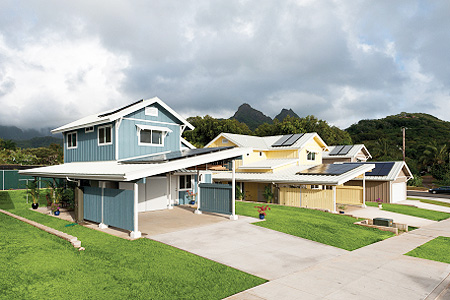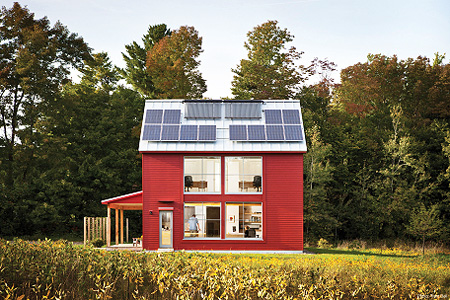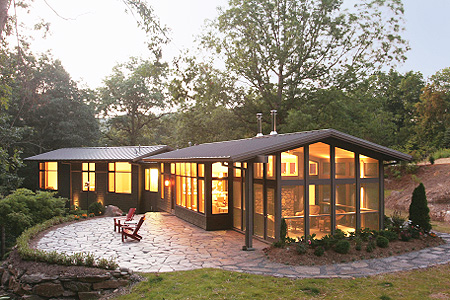5 Green Homes That Won Gold
September 23, 2011
The gulf between "green" and "gorgeous" seems to be narrowing. EcoHome magazine's second annual design awards singled out an array of houses that are not only environmentally exceptional, but look good at the same time.
It hasn't always been so.
"I don't want to say that good design and green haven't met in the past, but I think that they haven't been considered together as much as they are now," said Rick Schwolsky, editor in chief of the magazine, which recently bestowed its Grand Award designation on five homes from around the country.
Award winning green homes included:
• a subdivision of affordable homes in Hawaii;
• a passive-solar home in Carmel, Calif., that's so energy efficient that it has no air conditioning; and
• a major remodel of a 260-year-old home on Nantucket Island in Massachusetts that also had to meet architectural-preservation standards.
• a subdivision of affordable homes in Hawaii;
• a passive-solar home in Carmel, Calif., that's so energy efficient that it has no air conditioning; and
• a major remodel of a 260-year-old home on Nantucket Island in Massachusetts that also had to meet architectural-preservation standards.
The magazine, which specializes in green products and practices for the residential construction industry, chose a panel of five judges that included architects, builders who specialize in sustainable building, and experts on green technology.
Schwolsky, editor of the 4-year-old publication, said that although various organizations offer design awards for "greenness," EcoHome ups the competition by requiring that the environmental considerations of each home in the contest be certified by an independent third party.
Those third parties can include the U.S. Green Building Council's Leadership in Energy and Environmental Design (LEED) green-building certification program, or the National Green Building Program administered by the National Association of Home Builders, among others.
What does "green" mean these days? For some time, he said, the ability to cut the heating and cooling bills has dominated consumer thinking, and that's probably still true. Use of recycled content, the end-of-life disposability of products, and site sustainability are all green criteria, he suggested.
Here are the five award-winning Eco-friendly homes:
Project: Caterpillar House
Location: Carmel, Calif.
Architect: Feldman Architecture
Builder: Groza Construction
Location: Carmel, Calif.
Architect: Feldman Architecture
Builder: Groza Construction
 |
| The Caterpillar House in Carmel, CA Photo: Joe Fletcher Photography |
The Caterpillar House sits on a bluff in the Santa Lucia Preserve in Carmel, Calif. Its east-west, slightly curved layout maximizes passive solar gain, and additional energy savings come from concrete floors and rammed-earth walls that act as a thermal mass to protect against temperature fluctuations. Overhangs shade the south- and west-facing low-e windows. Ceiling fans and cross-ventilation also work to eliminate the need for air conditioning. A 27,300-gallon rainwater harvesting system supports all site irrigation, and all the plantings are native and drought-tolerant. The house has sustainability-certified cabinetry and reclaimed cork flooring. It has received LEED-Platinum certification.
Project: Kumuhau Subdivision
Location: Waimanalo, Oahu, Hawaii
Cost: Homes range in price from $225,000 to $325,000; average $121 per square foot
Architect: Armstrong Development
Builder: Armstrong Builders
Location: Waimanalo, Oahu, Hawaii
Cost: Homes range in price from $225,000 to $325,000; average $121 per square foot
Architect: Armstrong Development
Builder: Armstrong Builders
 |
| The Kumuhau subdivision on the Hawaiian island of Oahu. Photo: David Franzen, www.franzenphotography.com |
Kumuhau subdivision in Waimanalo on the island of Oahu got praise not only for its green attributes, but also its price tag -- the five floor plans in the 45-home subsidized project cost from $225,000 to $325,000. Contest judges applauded the developers for taking a risk by forgoing air conditioning -- the homes use whole-house fans to exhaust hot air into the vented attics. Each house uses solar panels to supply about two-thirds of their electricity, and the homes are wired to accommodate more solar panels and to charge up an electric car. Rainwater is collected in 51-gallon storage for drip irrigation.
Project: Nantucket Island home remodel
Location: Nantucket Island, Mass.
Cost: $273 per square foot
Architect: Rosenberg Kolb Architects
Builder: Knapp Construction
Location: Nantucket Island, Mass.
Cost: $273 per square foot
Architect: Rosenberg Kolb Architects
Builder: Knapp Construction
 |
| Nantucket Island remodeled home. Photo: Steve Moore |
It wasn't enough that the owner of a 264-year-old home on Nantucket Island in Massachusetts wanted an addition that was conservation-minded; the house also had to pass muster according to local historic-preservation guidelines. The extensively insulated and sealed 260-square-foot addition included a kitchen, bathroom and entry, and new mechanical and ventilation systems; the project restored the original single-pane window sashes to conserve energy while meeting historical architectural standards.
Project: GO Home
Location: Belfast, Maine
Cost: $150 per square foot
Architect: GO Logic Homes
Builder: GO Logic Homes
Location: Belfast, Maine
Cost: $150 per square foot
Architect: GO Logic Homes
Builder: GO Logic Homes
 |
| The GO Home in Belfast, Maine. Photo: Trent Bell Photography. |
The GO Home in Belfast, Maine, is 1,300 square feet of near-zero energy use. It's the 12th house in the country to earn the rigorous Passive House designation from the Passive House Institute. Its LEED-Platinum certification is pending. Built with structural insulated panels and passive-solar features, it's expected to save up to $170,000 in energy costs over 30 years -- almost what it cost to build, according to EcoHome.
Project: Celo Residence
Location: Celo, N.C.
Architect: Samsel Architects, Asheville, N.C.
Builder: Sunspace Homes, Burnsville, N.C.
Location: Celo, N.C.
Architect: Samsel Architects, Asheville, N.C.
Builder: Sunspace Homes, Burnsville, N.C.
 |
| Home in Celo, N.C. Photo: David Dietrich Photography. |
(http://realestate.yahoo.com/promo/5-green-homes-that-won-gold.html)